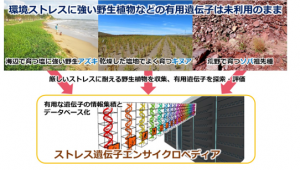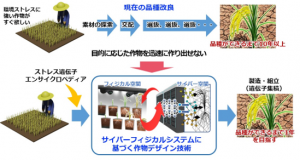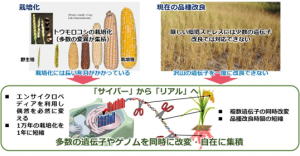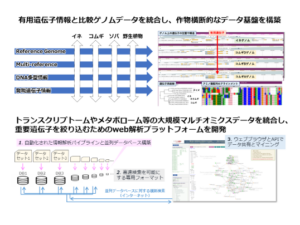Issues to be resolved
The main reason for the slowdown in the production of major grains is that the current varieties supporting production have lost much of their adaptability to environmental stresses during the process of cultivation. To solve this problem, there is an urgent need to develop robust crops that can be grown in poor environments such as under conditions of nutrient and water deficiency.
However, there are three major problems with current breeding practices that prevent this from happening.
Problem 1: We have not been able to utilize the strong stress tolerance of wild plants.
Problem 2: We cannot design crops quickly enough to meet our objectives.
Problem 3: It is not possible to improve a large number of genes at once.
In order to solve these problems, this project will accomplish the following three tasks.
Task 1: Developing robust crops
Elucidating the resilience of wild plants and other organisms for use in crop design
We will create an encyclopedia of stress tolerance genes in wild plants and use it to design stress-tolerant crops.

- We will conduct genome analysis, non-destructive growth physiology analysis, and multi-dimensional gene expression correlation analysis using wild plants and underutilized crops that have high potential for environmental adaptation.
- From the results obtained, we aim to elucidate the specific processes of stress tolerance in wild plants and other crops, and to utilize stress tolerance genes that have not been used so far in crop design.
Task 2: Digital Crop Design
Designing crops for various purposes in cyberspace
We will develop crop design technology using cyber-physical systems (CPS) and non-destructive plant phenotyping tools for high precision omics data acquisition to support CPS.

- Based on CPS using multi-omics data, we will construct a gene-based growth prediction model to enable the design of phenotypes (plant growth).
Namely, we predict crop growth from omics data in cyberspace. We then make plants according to the predicted optimal gene combinations for a particular environment and evaluate their growth in physical space. Next, we incorporate the results obtained in physical space into the original growth prediction model in cyberspace. Through this CPS cycle, we aim to improve the accuracy of crop design and eventually realize crop design in cyberspace.
Task 3: Genome dynamic modification
Create crops freely according to designs
The goal of this project is to develop technology for rapidly modifying the genome according to a design created in cyberspace to materialize a crop.

- We will advance genome editing technology, develop new dynamic chromosome rearrangement techniques, generalize genome editing technology for wild plants and low-use crops, and create new plants by adding chromosomes from wild plants.
- Furthermore, we will develop technologies for simultaneous genome multi-region modification and chromosome introduction to enable new cultivation of wild plants and rapid recultivation of crop wild species.
Task 4: Encyclopedia of stress tolerance genes
Developing genetic information for crop design
We will build an encyclopedia (data base) to promote the crop design using genome and gene function information of wild plants.

- We will develop comparative genome analysis techniques and tools to construct an integrated omics data platform.
- We will develop a web analysis platform to narrow down important genes using large-scale multi-omics data.
